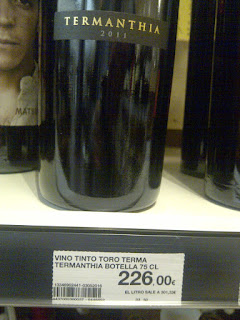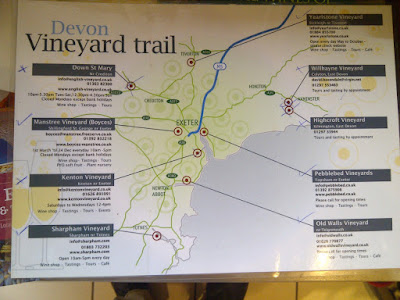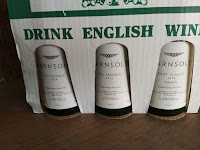 |
| The card says 'Cote du Jura Rouge Bourdy 1942 Jura 75cl £671.00' |
Thursday 20 October 2016
Tuesday 11 October 2016
Our 2016 (part 1).
 |
| Cheeky mushrooms all over the place |
On advice from Roger White from Yearlstone Vineyard, who told us you could mix different sprays in your own preparation, we sometimes mixed sulphur, copper sulphate and liquid seaweed together with the milk to make foul smelling, sometimes cheesy liquid which we were sure must do something.
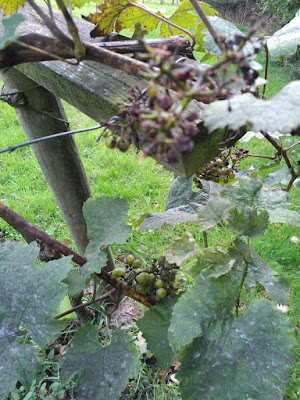 |
| Mildewed Bacchus. Note the milk residue on the leaves. |
Alas no. Either our spraying technique was to blame (you are supposed to spray the underside of the leaves but that was too much of a fag) or as we said, the whole think was cockamamie. Next year - chemicals.
It had all started so positively. The pruning was not too demanding as we decided that the summer pruning of the Triomphe should serve and we would see what happened if we left those vines alone (about one-third of the total). This turned out not to make much difference apart from the fact that we had to carry out drastic summer pruning again later on.
 |
| Bacchus before |
 |
| and after |
| note mild hailstorm. |
Manure? Yes, surely that is where we had been going wrong all these years. We read about how you have to feed the vines and how the French spread tons of the stuff all over the vineyard. You are supposed to dig it in or plow it of course but again, we weekenders don't have the time for those sorts of refinements. No wonder it seemed to make no difference apart from encouraging the weeds.
All those weeds required some strimming later on. More backbreaking stuff, enlivened by the discovery of various eggs under a couple of vines. Probably from pheasants who knows when.
In the hopeful stage before the mildew had set in, there was even for the very first time a flowering on our wierdest vine in the vineyard. This is obviously some kind of scientifically berserk crossing with some triffid-like germplasm. Every year we cast a baleful eye on this plant and take care to keep its ridiculously vigorous tentacles off its neighbours. It has never born fruit. The only positive thing you can say about it is that it is impervious to mildew or any other illness. Sadly, this fruit was not to develop and later was nowhere to be seen. Never mind. It would probably have been sour.
As has been mentioned in this blog already from time to time, we actually grew some vines from bare wood cuttings in 2016. They were less of a success than we anticipated at one stage. Nonetheless we were able to plant
4 x Baco Noir
4 x Saperavi Severny
1 x Abouriou
1 x Acadie Blanc
1 x Rauschling
1 x Elbling
Of these, only the Elbling didn't survive the planting out. Indeed the Baco Noir, Saperavi Severny and Acadie Blanc turned out to be quite vigorous customers.
During the season we also bought 4 x Pinot Blanc at a knockdown price online from a Dutch nursery (3 survived), a Black Hamburgh (Schiava Grossa) from the local garden centre which was very vigorous indeed until some animal denuded it of all its leaves above the rabbit guard and a half-price Muscat d'Alexandrie which we were told should probably be grown indoors. Well, we do call it an experimental vineyard.
The baby red grapes in our more recent plantings (Rondo, Regent, Dornfelder, Pinot Noir, Wrotham Pinot (Pinot Meunier) and Fruehburgunder were a mixed bag. In general the vigour of these vines is poor where we have planted them.
Some predator (wasps? Birds?) always go for our Rondo first.
So our hope are pinned once again on the 'mal-aimé' Triomphe. This time we are thinking of making it by the Carbonic Maceration method having been inspired by the Ancre Hill Triomphe we had tasted at the Real Wine Fair earlier in the year.
As anyone with any knowledge of Viticulture and Winemaking reading this post will have determined from the start, we are not exactly gifted at either discipline and have close to zero aptitude. Nonetheless, we are game so one rainy Friday morning we paid a call to Eskimo Ice at Nine Elms Market in London next to New Covent Garden to buy some food grade dry ice.
From there to Hatfield to buy some grapes. The idea was to make an experimental run at this Carbonic Maceration mularky before subjecting our own crop to it. Basically you put whole bunches of grapes in an airtight container, fill it with Carbon Dioxide and seal it with an airlock. In three weeks, the grapes are supposed to ferment from the inside out.
 |
| Winegrapes Chris |
Chris has a tremendous operation in Hatfield. he sells grapes from Italy (Puglia) and Spain (Valencia) to the various communities throughout the UK. The communities then make the wine at home like in the old country. We have met practitioners as far away as Edinburgh. The varieties on offer included
 | ||||||||||
as well as a newcomer, Macabeo. We decided to buy Sangiovese and Trebbiano.
Back at the ranch we had a bit of difficulty with the dry ice. It will only release its CO2 when in contact with water. We didn't think water in the bottom of the fermenter would be a good thing so we layered some dry ice pellets in with the bunches of Sangiovese.
Some of the grapes had burst and thiis provided the liquid for the dry ice to release the gas. Unfortunately we had probably put far too much in because the action was over-dramatic. Since then - nothing, although the three weeks aren't yet up at the time of writing.
With the rest of the grapes we hurriedly made red and white micro-vinifications. Try this at home!
 |
| Trebbiano plug |
 |
| Sangiovese must |
We'll be sure to report on how all this turns out.
Sunday 2 October 2016
Wine in a time of Brexit
 |
| Sign of the times? Seen in Kent. To Cape Town, Hawaii, Tokyo, Los Angeles. |
On a number of visits to English vineyards this summer we can report that quality is already approaching a level good enough to recommend home grown wines in the world market. Already we have a burgeoning reputation for sparkling wines which seems to be what home-grown we'll be famous for. Our interest here is more concerning table wines although all the producers we visited also make sparkling wine. We think we will need a USP for these table wines . Slotovino reckons we may have one already: our uniquely low ABV values. You may disagree but what other country produces the majority of its wine at 12% or under? We've indicated the alcohol levels wherever possible in this post.
Devon
Our first vineyard was Dalwood, East Devon.
At this nice shop in Honiton we heard about the villagers of Dalwood village nearby who had clubbed together to plant a 1.1 ha. vineyard with Seyval Blanc, Solaris, Madeline Angevine and
We drove up and down passing the St. George's cross flag outside the church several times trying to get sight of the vineyard. Finally we learned that it was some way up a muddy hill so we settled for a visit to the village shop.
A range of the Dalwood wines were on sale there. We didn't find out if there was a cellar door but this served the purpose well. We haven't tried the wine yet but what a great story and congratulations to the villagers on their Decanter Bronze medal. Maybe others will be inspired to follow in their footsteps?
 |
| 11.5% |
What vines we have at our hobby experimental plot in the Thames Valley began with vines supplied by Gillian Pearkes who owned the vineyard until the early 1990s up to that time. Her book 'Winegrowing in Britain' was essential reading in those days and is still very interesting even though things have evolved tremendously since then. Triomphe d'Alsace was recommended to us at that time. As well as that we obtained the much better but much more difficult Bacchus from Yearlstone, so on meeting the current owner, Roger White, we introduced ourselves as his offspring.
 |
| Roger and Juliet White, owners of Yearlstone Vineyard |
 | ||
| Interesting red earth in the upper block |
Roger has removed all the Triomphe and now farms Bacchus, Madeleine Angevine, Pinot Gris, Reichensteiner, Seyval Blanc and Siegerrebe for the whites and Dornfelder, Pinot Noir and Rondo for the reds. The vineyard extends over 7 ha. There is further land in an upper block but that would not be feasible with the labour he has - mostly himself and Juliet.
 |
| Nice welcome at the cellar door |
 |
| Facilities aplenty |
 |
| The bellwether Triomphe vine |
 |
| The Yearlstone back label fits all apart from the alcohol level which changes slightly. |
 |
| Reichensteiner, 11.5% |
 |
| We purchased the Rose (from bought-in Regent), 11% |
 |
| and the Red (Rondo) 11.5% |
 |
| An interesting plan of the vineyard. How often do you see that? |
Sussex
Sussex is familiar territory for great Sparkling Wine names including Bluebell, Bolney, Breaky Bottom, Davenport, Nyetimber, Plumpton College and Ridgeview. Our goal was Sedlescombe, one of the only Organic/Biodynamic vineyards in the country. How they do it we cannot tell. Our experience in this country involves more chemical spraying than one likes to think of given our damp climate.
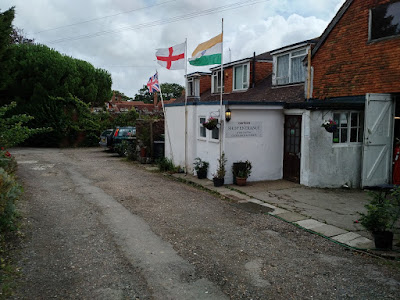 |
| Note the St. George's cross and Indian flags! |
The winemaker is Alex Carr Taylor, the highly qualified son of the founders. His wife is also involved so Carr Taylor remains very much a family affair.
There is a welcoming tasting room and cellar door too.
 |
| 11% |
We went for a bottle of Bacchus seeing as how that will allow us to make comparisons with so many other English and Welsh vineyards.
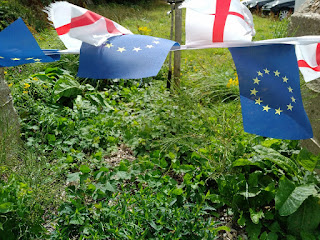 |
| Here the bunting suggested another point of view from what we had become used to. |
Meals are to be had at the Cellar Door/Tasting Room.
 |
| 12% |
Sedlescombe wines are to be found reasonably widely but here we could buy a 2004 Regent and there was even a red at nearly £70 a bottle. We'll take it it's excellent.
Varieties grown include Bacchus, Chardonnay, Dornfelder, Faber, Johanniter, Mueller-Thurgau (which they refer to as Rivaner), Orion, Pinot Noir, Regent, Reichensteiner and Rondo. All these grapes are grown to Demeter standards and are certified as such.
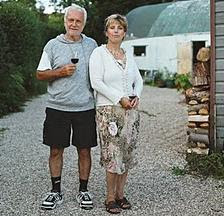 |
| Roy and Irma Cook |
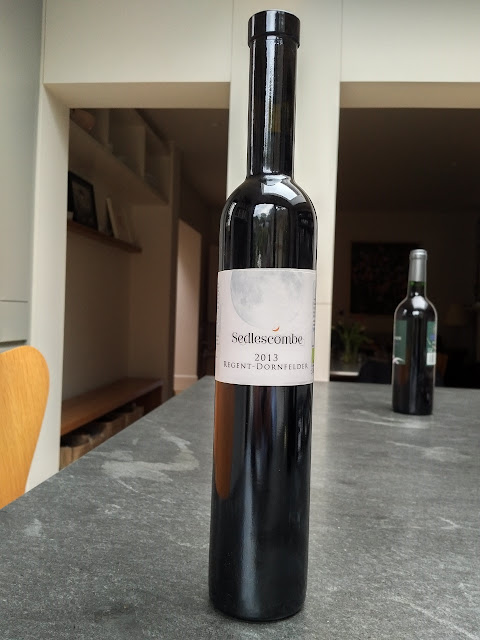 |
| 11.5% |
The Sedlescombe 2013 Regent/Dornfelder came in an interesting tall bottle. On asking what the significance of this might be, we were told they ran out of normal bottles. Sweet.
Kent
Phillip and Sally White greeted us hospitably while dealing kindly with other visitors. According to Phillip Barnsole is the only remaining vineyard out 13 in the area. They themselves acquired it only a few years ago after growing vines on an allotment and studying at Plumpton.
 |
| Phillip shining a light on Pinot Noir already in the fermenter in September |
A lot of the equipment was already in place.
Varieties grown include Chardonnay, Pinot Meunier, Pinot Noir, Huxelrebe, Regent, Reichensteiner and Rondo. They also inherited a row of Dornfelder. Their sparkling wine is currently made from the original blend of Huxelrebe and Reichensteiner.
 |
| Huxelrebe 13% |
 |
| Reichensteiner 12% |
 |
| Red Reserve (Rondo) 11.5% |
Our 3 - pack consisted of Kent Classic (Huxelrebe) and Dry Reserve (Reichensteiner) and Red Reserve (Rondo). The Reichensteiner is the most characterful and least neutral of its kind we have ever tasted. Like Phillip, we are fans of Huxelrebe. His example reaches 13% which is rare. He says if he put Huxelrebe on the label no one would buy it. We agreed someone has to make a feature film with a Huxelrebe scene.
English wineries are on the increase no doubt but it is still a precarious operation. Things change in the so-called Off-trade. This nice shop in Broadstairs is for sale due to the retirement plans of the owners who have run it since 1988, picking up awards on the way.
 |
| 12% |
This Fruehburgunder/Pinot Noir/Dornfelder blend from Chapel Down was offered at a great deal less than at Harvey Nicks
 |
| 10% |
and we also bought this excellent Dornfelder from Gribble Bridge (Biddenden) which we had enjoyed before. Both Chapel Down and Gribble Bridge are Kentish vineyards.
Sussex (again), Hampshire, Lincolnshire and Norfolk
 |
| 10.5% |
Plumpton Estate is in Sussex. The Cloudy Ridge Red is made from Rondo and Dornfelder.
 |
| 10.5% |
There are vineyards in Hampshire too. Somborne Valley seems an interesting one to explore another time. The combination of Pinot Blanc and Pinot Meunier would seem an obvious one but we can't say we have come across it previously anywhere else.
 |
| 12% |
Somerby Vineyards in Lincolnshire also merit a journey. We have been enjoying their Solaris for some time already. Now under the name Magna Carta it is available online from Waitrose at a good price.
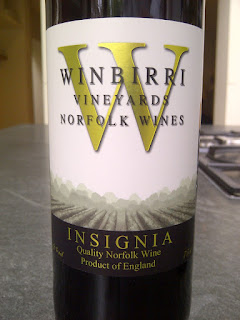 |
| 12% |
You'd have thought Winbirris had to be Australian but no, it's from Norfolk. Their Insignia red is a blend of Dornfelder, Rondo and Regent. There are now a mighty handful of really good English reds. This is one of them.
Wales
 |
| 10% |
Subscribe to:
Posts (Atom)
